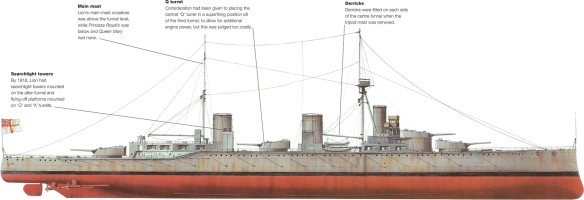
Larger than the contemporary German battlecruiser Seydlitz, and only half a knot faster, Lion’s armour accounted for 23 per cent of displacement, while Seydlitz’s was 31 per cent.
The deck plan shows how much of Lion’s 213.4m (700ft) length needed protection because of the spacing of the 342mm (13.5 in) turrets.
Battle of Dogger Bank
The Battle of the Dogger Bank was fought when, from intercepted radio messages, the British came out to forestall a German bombardment of coastal towns: Admiral Beatty’s force of five battlecruisers – Lion, Tiger, Princess Royal, New Zealand and Indomitable – with seven light cruisers and 35 destroyers against Admiral Hipper’s three battlecruisers, Seydlitz, Moltke and Derfflinger, one armoured cruiser, Blücher, four light cruisers and 18 torpedo boats.
Outnumbered, Hipper sought to avoid a battle but the faster British force pursued his ships in a stern chase and by 09:30 on 24 January they opened fire at long range. The disabling of Lion, with all electrical power lost, prevented Beatty from giving effective signals, and the German ships, except for Blücher, got away. Though indecisive, the battle was considered a British tactical victory and enhanced the reputation of the battlecruisers, despite the damage to Lion having revealed the British ships’ lack of staying power under heavy gunfire.
The Lion class
The three ships of the Lion class were the first battlecruisers to carry 342mm (13.5in) guns, and were the largest and fastest capital ships yet built; they were also the most expensive. But they had serious defects.
The British Navy adopted the superfiring turret arrangement in HMS Neptune (commissioned November 1911), and with the Orion class of battleships (commissioned January 1912) introduced the ‘super-dreadnought’ with 343mm (13.5in) guns. These aspects were combined in the Lion class battlecruisers. Britain had introduced the battlecruiser, as an enlarged version of the armoured cruiser, with HMS Invincible, commissioned in 1908. Like HMS Dreadnought, it was a project begun and driven by Admiral Lord Fisher who believed it to be tactically and strategically superior to the battleship.
Lion was the third class of battlecruiser to be introduced, laid down at Devonport Naval Dockyard on 29 November 1909, launched on 6 August 1910 and commissioned on 4 June 1912. Two others, Princess Royal and Queen Mary, completed the class. Each ship cost in excess of £2,000,000. The German Navy had responded rapidly to the implicit challenge: SMS Moltke was commissioned in September 1911 while Lion was still fitting out, and Derfflinger was laid down in January 1912. Moltke carried 10 208mm (11.1in) guns.
Design errors
Lion’s design followed that of Dreadnought and Orion by having the fore-funnel placed in front of the mast. As a result sparks, smoke and heat made the masthead installations often uninhabitable. The bridge, placed on top of the conning tower, suffered similarly. In 1912 the original tripod mast was replaced by a single pole mast with a light spotting top, and the funnel was moved behind it, though still very close. The second and third funnels were heightened to be uniform with the fore-funnel.
Although the ‘A’ and ‘B’ turrets were set in a superfiring arrangement, there was only a single aft ‘Y’ turret, with a central ‘Q’ turret placed between the second and third funnels, separating the boiler rooms below. Rangefinders were located in ‘B’ and ‘Y’ turrets and in the conning tower, with the fire-control position (this was later transferred to the mast, which was fortified by struts to support it). The ships carried 16 102mm (4in) guns for anti-torpedo boat defence, their batteries aligned so as to have six firing ahead, eight abeam and four astern. Two 533mm (21in) torpedo tubes were below the waterline on either side of ‘A’ barbette. In 1917 searchlight supports were fixed on the mast and the after funnel.
Armour limitations
The most controversial aspect of the battlecruiser, certainly after the Battle of Jutland, was its relative lack of armour protection. Speed was the great requirement insisted upon, and greater speed meant greater length and more surface requiring protection. In fact the vulnerability of the Lion class was more due to insufficient understanding of the flash effects of a shell explosion and the countermeasures necessary, rather than of lack of armour as such. Belt armour was fitted up to main deck level for the first time, but the armoured deck was only 25.4mm (1in) thick, and the barbettes extending down into the hull had 76.2mm (3in) armour. Altogether, armour weight came to 5624 tonnes (6200 tons) or 23 per cent of the design displacement. By comparison the German Moltke had belt armour to a maximum of 270mm (10.6in) and an armoured deck of 50mm (2in).
Lion joined the 1st Cruiser Squadron on commissioning, then was flagship of the 1st Battlecruiser Squadron from January 1913. In the 1914–18 war it was flagship of the Battlecruiser Fleet, and gave long-range support at the Battle of Heligoland Bight on 28 August 1914. At the Battle of the Dogger Bank, the only fight exclusively involving battlecruisers on 24 January 1915, a shot from Lion knocked out the rear turret of Admiral Hipper’s flagship Seydlitz, but Lion sustained 17 hits including two on the waterline, narrowly avoided flooding of the engine room, and fell out of the action. Towed back by Indomitable, it spent four months under repair.
At the Battle of Jutland, 31 May 1916, Lion took a direct hit on ‘Q’ turret, whose officer, Major Harvey, died as he flooded the magazines, saving the ship. But its sister ship Queen Mary was blown up, with Indefatigable and Invincible. Lion was repaired by 19 July and continued in North Sea operations until the end of the war. In 1921 it was decommissioned under the Washington Agreement and was sold for breaking up in January 1924.